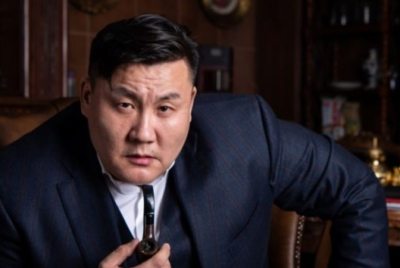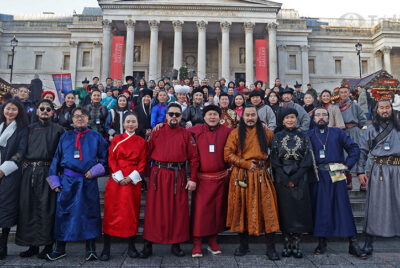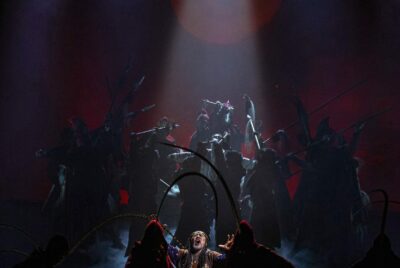
The Mongol Khan
Photo Shinee
The Mongol Khan, a spectacular fusion of story, dance and music comes to the London Coliseum this month. David Mead looks ahead to the production with director Hero Baatar and choreographer Bayarbaatar Davaasuren.
Mongolia. 2000 years ago. A brutal succession battle threatens the very stability of the Empire. As the great Khan struggles to maintain his supremacy, a plot hatches that will forever alter the balance of power.
Inspired by real events and the well-known play of the same title (also known as The State without a Seal), by Lkhagvasuren Bavuu, one of Mongolia’s distinguished writers and poets, The Mongol Khan promises all the ingredients of a classic historical tale. As it fuses music, dance, song, dialogue and puppetry, Hero Baatar promises audiences will witness jealousy, deceit, mistaken identity, adultery, rivalry, sacrifice, the struggle for power and succession. With over 70 performers, and elaborate sets and costumes, all inspired by traditional nomadic culture and tradition, it sounds spectacular too.

Photo Bolor-Erdene Baljinnyam
Noting Mongol culture’s unique tradition of musical dramas that seamlessly blend circus, dance, song, and long storytelling, he describes it as a “quintessential Mongol drama.” It is typical of “a uniquely Mongol way of storytelling that goes back centuries,” he says.
Besides telling its story, Bayarbaatar Davaasuren says that “The Mongol Khan is a window on the Mongol spirit and cultural legacy handed down over generations. He promises that viewers will be transported into their world and will witness their way of life, beliefs, customs and unwavering spirit. He calls it “a truly distinctive work of art… a marvellous showcase of all that Mongolia has to offer.”
While it brings together many elements, the life force of the production is dance, says Davaasuren. He says that audiences will see it in many different forms from the traditional dances of many of Mongolia’s ethnic groups, to modern dance and free movement sequences. “It is a captivating tapestry of movement and expression.”

Photo Bolor-Erdene Baljinnyam
He continues, “Much like Chinese dance, traditional Mongolian dance boasts a rich array of genres, from court dances to telling stories from history, modern interpretations to shamanic rituals, and folk expressions to ceremonial displays.” It also has a very long heritage, stretching way back beyond the time of Genghis Khan (who ruled from 1206 to 1227), when he tells how over 360 dancers would grace the Khan’s palace, accompanied by a 560-strong orchestra. “Such grand court dance added an air of elegance to festivities and banquets.”
Baatar explains that Mongolian traditional dance reflects of nomadic life, drawing on movement from everyday activities and rituals. “This tradition takes the ordinary, such as crafting, sewing, and daily customs, and weaves them into expressive dance gestures and movements. The dancers, through their graceful and extraordinary movements, skilfully unveil the inner narratives, emotions, and expressions of the characters.”

Photo Bolor-Erdene Baljinnyam
Davaasuren adds, “Many styles are characterised by exceptional beauty and precision. Mongolian celebrations also often feature swift dances that mark the incredible speed of their horses; military dances, characterised by powerful stomping leg movements, showcase the formidable power and prowess of the Mongol army; and ritual dances play a crucial role in honouring ancestors and the revered spirits of the mountains and waters. All these diverse forms have found their place in The Mongol Khan.”
Of the many dance styles, Davaasuren specifically picks out the traditional biyelgee, which he explains is, “A tradition passed down through generations, through master-apprentice relationships, often from father to son. This dance, rooted in the ancient history of the Mongols, embodies the essence of tengri (heaven), Earth, and humanity, which resonate deeply within the Mongol culture. Through this spirited circle dance, a ritual call, the Mongols offer their respect to heaven and Earth.”
But, while the dance in The Mongol Khan features many traditional forms, Davaasuren says the choreography is also influenced by modern and contemporary dance. The innovative infusion of new, modern styles, creates a blend of harmonious tradition and innovation, which he believes firmly are not mutually exclusive. “They can coexist harmoniously and do in this production.”

Photo Bor Injinash
That coming together of new and old reflects how dance in now practiced in modern-day Mongolia. Dance is very much part of growing up and widely practiced from early childhood, he says, explaining that, these days, children learn classical ballet and modern dance alongside traditional forms. “Today, the younger generation finds joy in street dances, where the traditional biyelgee dance and others are infused with modern trends.”
Audiences can expect to see other movement forms too, not least some graceful contortion, an unusual art form for which Mongolia is renowned. There’s also puppetry and what is known as the Three Manly Games of Nadaam: wrestling, horse-riding and archery. “What is truly remarkable, is the harmonious fusion of these stunning arts within the dance,” says Davaasuren
Accompanying the movement and dance, the music features many traditional instruments and techniques. Among those featured, Davaasuren picks out the shudarga, a three-stringed plucked lute; yatga, a traditional zither; and morin khuur, a rather fine looking traditional two-stringed fiddle with a rectangular sound box and long neck surmounted by a carved horse’s head. There will also be “mesmerising khoomei singing, an ancient technique by which singers reproduce natural sounds like the flow of water, the breath of wind and the singing of birds;” and “haunting urtyn duu, a long-song characterised by drawn out notes and complex vocal ornamentation.

Photo Bolor-Erdene Baljinnyam
The show’s designers have similarly drawn on tradition, says Baatar, faithfully recreating and presenting traditional dress, accessories, and jewellry that have been passed down through generations. Some archaeological treasures have also been realised and “bring historical artifacts to life before the audience’s eyes.,” he adds.
For the London performances of The Mongol Khan, the actors will speak in Mongolian with English surtitles, which should add another level of authenticity without distracting from the immersive experience.
The production has proved hugely popular in its homeland. Baatar tells how it has tapped into the national psyche, the profound significance it carries connected with Mongolia’s history of encounters with cultural invasions and external influences that date right back to the time of the Great Yuan Dynasty (1279-1368). Nestled in the heart of Central Asia, he observes how the country has always been a crossroads for diverse cultures, with its history shaped by the forces of Buddhism, the imprint of Manchu culture and rule, the influence of the Soviet Union, and, more recently, the global reach of American culture.

Photo Bolor-Erdene Baljinnyam
Amidst all these influences, preserving Mongolia’s traditional cultures is a challenge, he admits. But he believes that is what The Mongol Khan does. By seamlessly blending modern and traditional dance, and other classic features of traditional arts, the production is a masterpiece in its own right, he believes. “It’s no wonder that it instantly resonated with audiences, earning their adoration and acclaim.”
The way Mongolian audiences perceive and embrace this play is deeply rooted in their unique connection to it. The Mongol Khan is intricately entwined with the very fabric of Mongolian life: its customs, rituals, people’s inherent temperament, and the enduring spirit of Mongol pastoral society,” Davaasuren adds.
What is next for the creative team? Hero Baatar says he will be unveiling a traditional Mongolian opera that will celebrate the country’s musical tradition and outstanding singers. Bayarbaatar Davaasuren has hopes to create similar works, maybe a ballet rooted in the same principles but that relies wholly on the language of movement.
But back to The Mongol Khan. It maybe an intricately woven story full of intrigue and more but, says Davaasuren, it is also a vivid showcase of authentic Mongolian folk songs, music, dance, customs, and rituals. “A real celebration of Mongolian heritage.”
The Mongol Khan is at the London Coliseum from November 17 to December 2, 2023.





